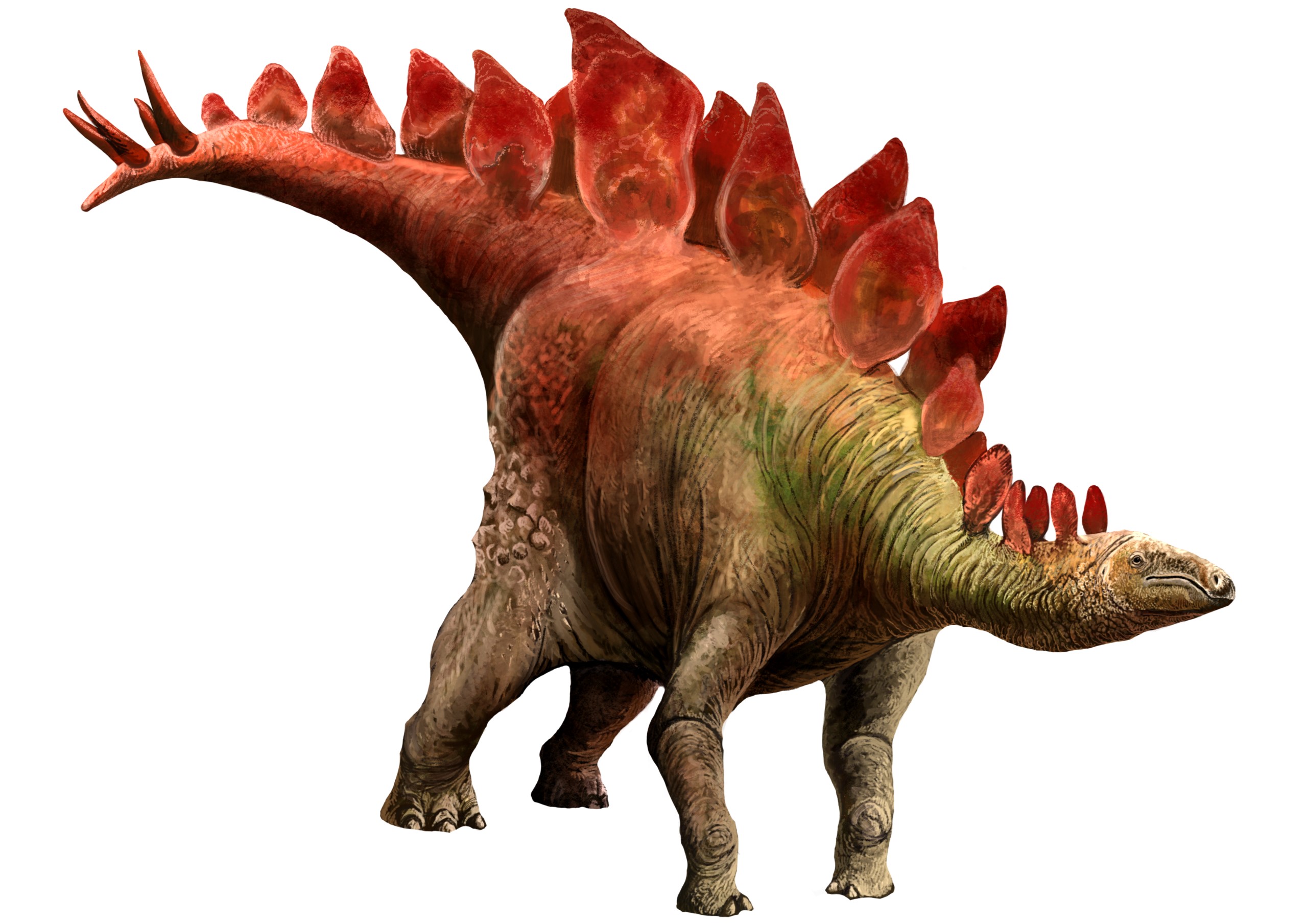
Credit: DataBase Center for Life Science (DBCLS), CC BY 4.0, via Wikimedia Commons
The stegosaurus is known for its unusual features: rows of large, bony plates along its back, spikes on its tail and a cranium so small that early paleontologists thought there must be another brain hidden elsewhere, like in a nerve bundle at the base of the dinosaur’s powerful tail.
But it was the purpose of those plates that really baffled scientists—a mystery they’ve been trying to solve for more than a century.
Initially it was thought the plates were for defense. But they cover only the animal’s back, leaving the rest of its body vulnerable.
Then it was thought they were used for thermoregulation. The stegosaurus could face them to the morning sun to absorb its heat. And later face them into the wind to cool down. But subsequent fossil finds didn’t show enough blood vessels in the plates for this to be likely.
The current hypothesis is that they were used to attract mates.
Fossils suggest that stegosaurus plates were attached to their skin, meaning the dinosaur may have been able to move them. The plates could have flopped and waggled when the animal walked. Some paleontologists think they may have been brightly colored.
Other stegosaurs might have found these features very attractive. Much like modern bird plumage.
Or perhaps different plate shapes and sizes were just used by the different stegosaur species to tell one other apart.
Perhaps we may never know. And with a brain that small, the stegosaur may not have either!
Background
Synopsis: Stegosaurus is one of Earth’s most recognizable dinosaurs, with its vertical plates arranged along its rounded back all the way to its spiky tail. This herbivore lived during the Jurassic Period, more than 70 million years before the demise of the dinosaurs. Its unique plates are a curiosity—scientists have been trying to figure out their purpose for more than a century.
- Stegosaurus is one of Earth’s most iconic and recognizable genera of dinosaurs.
- From about 155 to 145 million years ago, several species of stegosaurs lumbered through Late Jurassic landscapes of Laurasia displaying distinctive kite-shaped plates along their rounded backs and sporting big spikes on their tails.
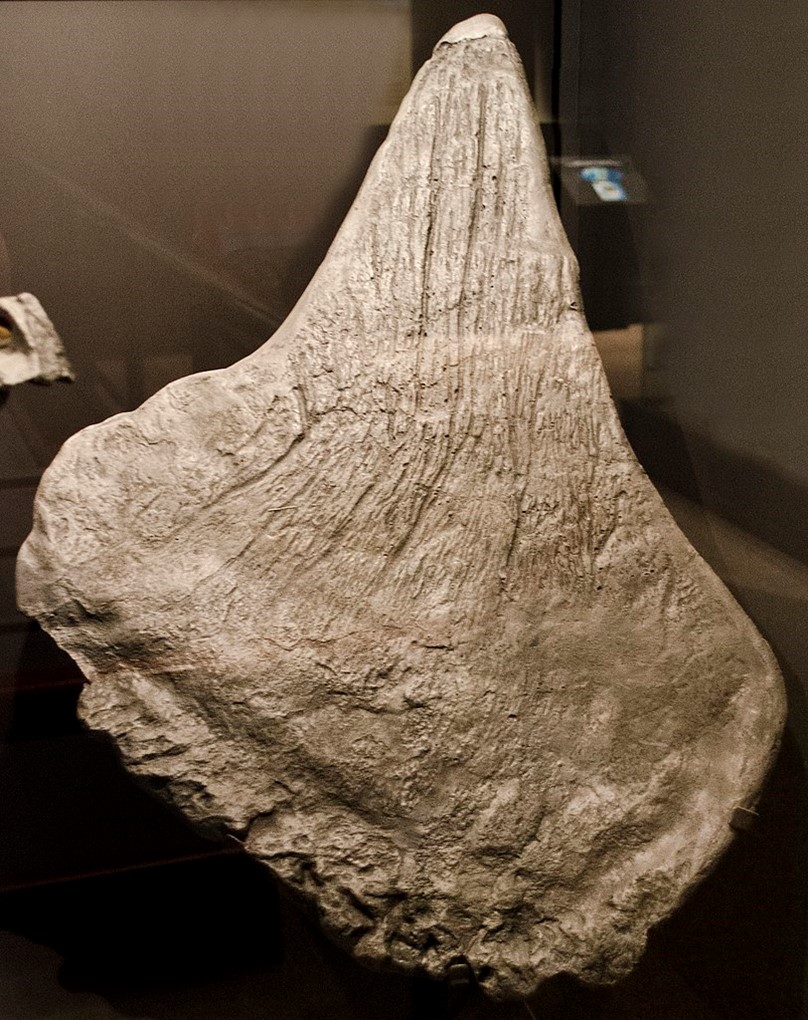
Fossil dorsal plate from a stegosaurus on display in the Museum of the Rockies in Bozeman, Montana. (It is not clear where this specimen was collected.)
Credit: Tim Evanson, CC BY-SA 2.0, via Wikimedia Commons - Depending on species, stegosaurs weighed up to 3 or 5 tons, were about 9 or 13 ft (3–4 m) tall, and were about 23 or 30 ft (7–9 m) long.

Scale diagram comparing a human to two of the largest Stegosaurus species. These dinosaurs were similar in size to an African bull elephant.
Credit: KoprX, CC BY-SA 4.0, via Wikimedia Commons - With their short forelegs and longer hind legs, their heads ended up about 3 ft (1 m) from the ground, enabling easy access to their herbivorous diet of bushes and shrubs.
- Their necks were short, and their heads were small. As a matter of fact, their brain cavity could only accommodate about 2.8 oz (80 g) of tissue, making it so small that early 20th century paleontologists once hypothesized they must have had a second brain in a skeletal void near their hips, which was not the case. Stegosaurs were likely just not very bright.
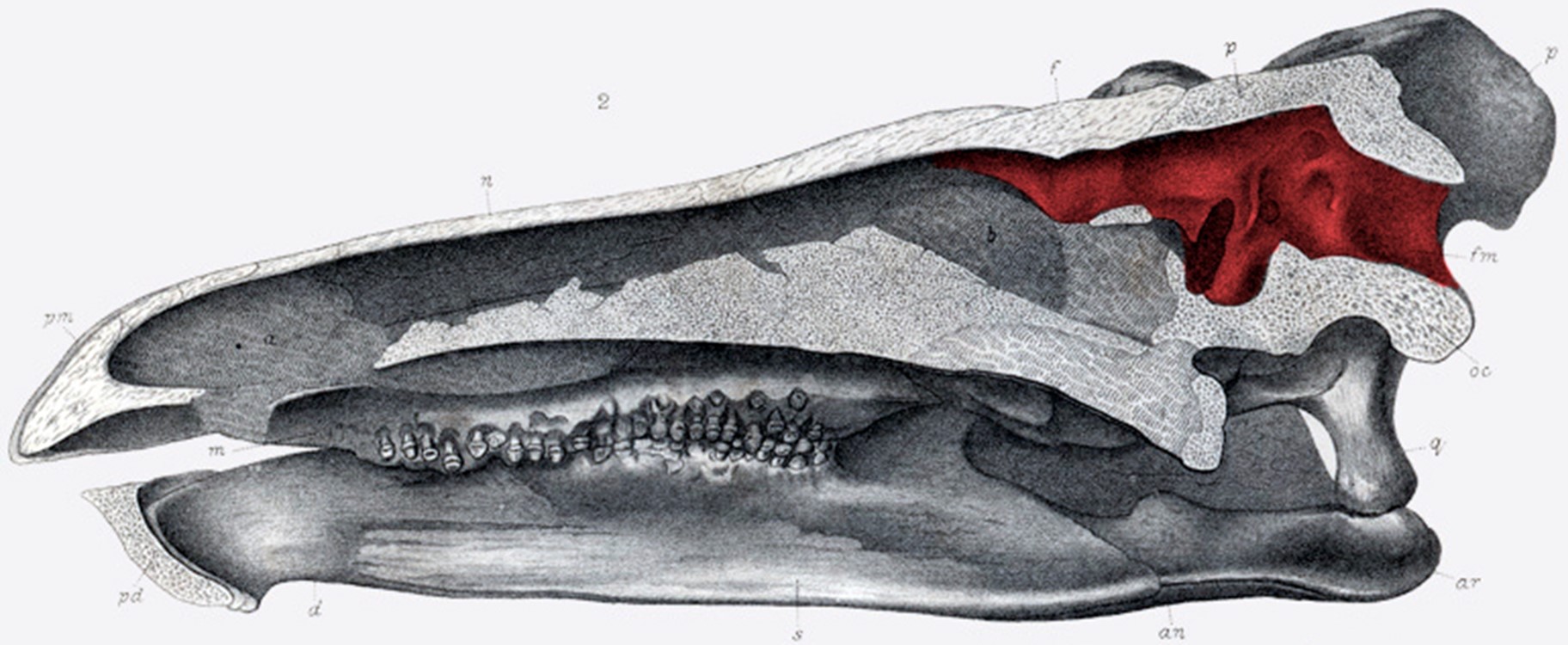
The brain cavity of this huge S. stenops is about the size of a walnut, marked with red in this image. This was an abnormally small brain-to-mass ratio for a dinosaur.
Credit: Frederick Berger, public domain, via Wikimedia Commons - Stegosaurus lived alongside other well-known Jurassic dinosaurs, including Apatosaurus, Diplodocus and Camarasaurus, and is thought to have been a favorite prey of Allosaurus.
- From about 155 to 145 million years ago, several species of stegosaurs lumbered through Late Jurassic landscapes of Laurasia displaying distinctive kite-shaped plates along their rounded backs and sporting big spikes on their tails.
- The name Stegosaurus means “roof lizard” or “armored lizard” because of the diamond-shaped plates found alongside fossil skeletons.
- In 1877, paleontologist Othniel Charles Marsh discovered the first Stegosaurus fossil in the Morrison Formation near Morrison, Colorado.
- He found partial skeletons with plates and spikes and formally described the genus in 1880, naming it in 1901.
- In the past century, other armored dinosaur fossil species with plates like Marsh’s dinosaur were discovered in western Europe, North America, China and Tanzania.
- Modern techniques such as biomechanical modeling, functional morphology and phylogenetic analysis have been used to better understand how the dinosaur moved and fed as well as how it behaved and evolved.
- The biggest mystery about Stegosaurus has always been the form and function of its unique plates.
- Marsh agonized over the placement of the plates, with an early hypothesis that they laid flat like shingled armor, but their form indicated they stood on edge.
- By 1891, he hypothesized that a single row ran along the spine of the animal.
- In 1901, scientists suggested they occurred in a double row, and this was the arrangement used for the violent stegosaur featured in the 1933 film King Kong.
- In the 1960s, some Stegosaurus stenops fossils were discovered with the plates still partially intact, showing two rows of alternating plates that were attached to the dinosaur’s epidermis, not to its spine. This would have resulted in plates that flopped around as the dinosaur moved, not the rigid plates previously hypothesized.
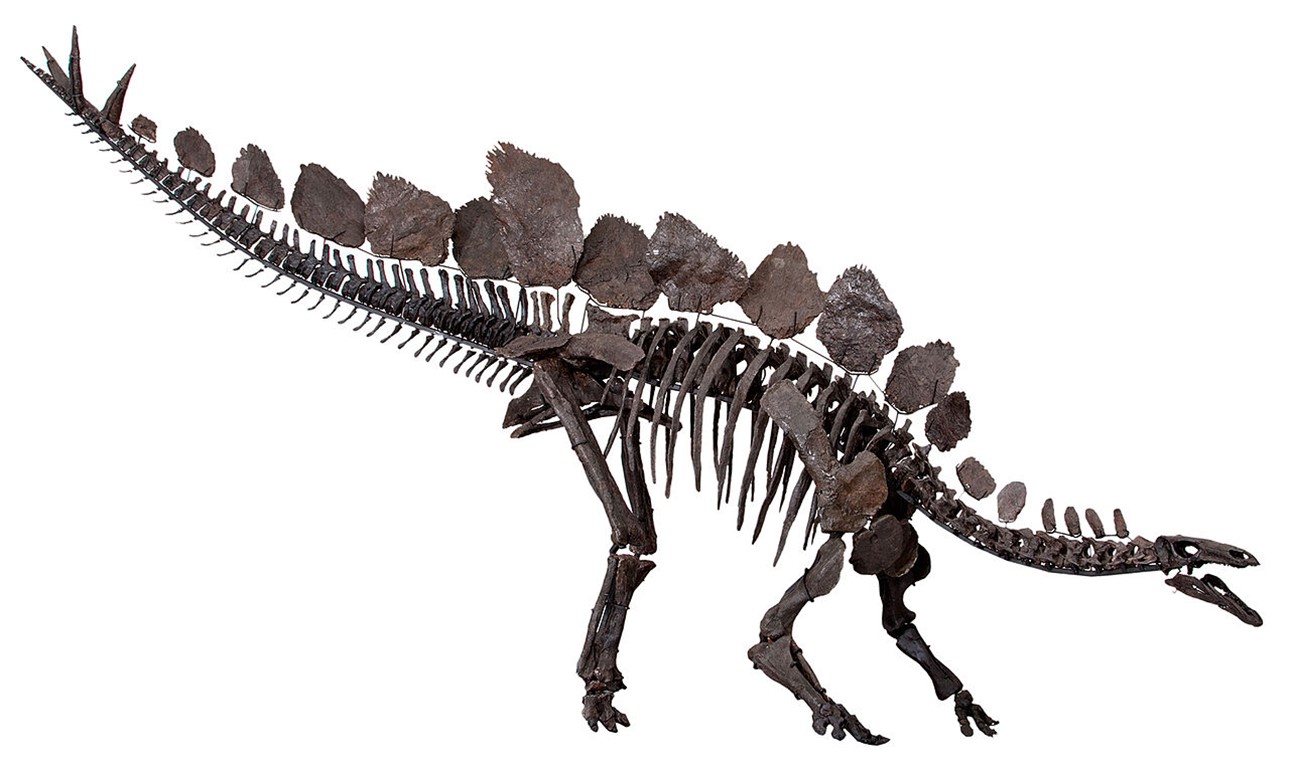
Mounted skeleton of S. stenops (specimen NHMUK PV R36730, "Sophie"/"Sarah") in right lateral view at the Natural History Museum, London.
Credit: Susannah Maidment et al. & Natural History Museum, London, CC BY 4.0, via Wikimedia Commons
- But today, scientists still struggle to understand the function of the plates.
- Some propose the plates were important for thermoregulation, with an extensive network of blood vessels that could absorb or dissipate heat as needed, controlling body temperature for these cold-blooded dinosaurs (ED-314 Dinosaurs Run Hot and Cold).
- Another possibility is that the plates were used for display and communication, possibly changing color as they flushed with blood, attracting mates and establishing social hierarchies. Different shapes of plates in different species may have helped with species recognition for mating and group cohesion.
- It is possible that the plates were a means of defense or intimidation, protecting the back of the stegosaur from attack and making their profile look larger. These plates may have been covered in keratin sheaths that made them sharp, and if they were floppy, they could be flipped from side to side.
- Currently, scientists are leaning toward the idea that the plates were for social hierarchy display, mating, recognition and possibly for thermoregulation.
- Another distinguishing characteristic of stegosaurs is their thagomizer, with its imposing spikes.
- S. stenops had four spikes that protruded horizontally from its tail, each of which was 2 to 3 ft (60–90 cm) long.
- After finding a stegosaur tail spike embedded in an allosaur tail vertebrae, the early belief that the tail spikes were defensive was confirmed.
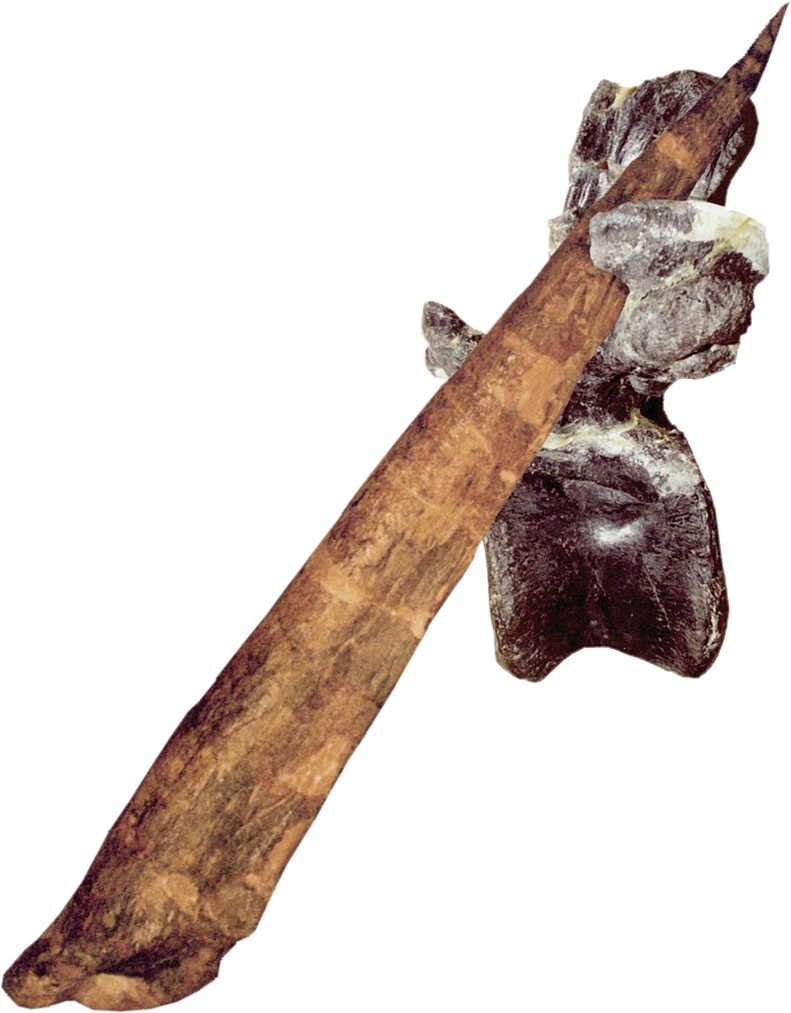
An Allosaurus tail vertebra punctured by a Stegosaurus thagomizer. A thagomizer is the distinctive arrangement of four spikes on the tails of stegosaurs. These spikes are believed to have been a defensive measure against predators.
Credit: Kenneth Carpenter, CC BY-SA 4.0, via Wikimedia Commons - The spike arrangement is known as a thagomizer after a Far Side cartoon by Gary Larson popularized the term.
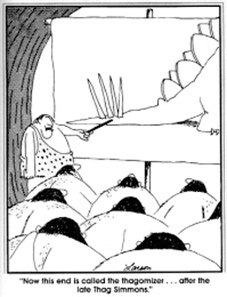
The original Far Side cartoon, drawn by Gary Larson in 1982, in which the term “thagomizer” was coined. The term is now commonly used in scientific circles. The original caption that went with the cartoon was “Now this end is called the thagomizer ... after the late Thag Simmons.”
Credit: Gary Larson via Wikimedia Commons
- Despite films and art frequently depicting the two famous dinosaurs together, Stegosaurus was separated in time from Tyrannosaurus rex by more than 80 million years—humans are separated from T. rex by just 66 million years (ED-348 Deep Time).

